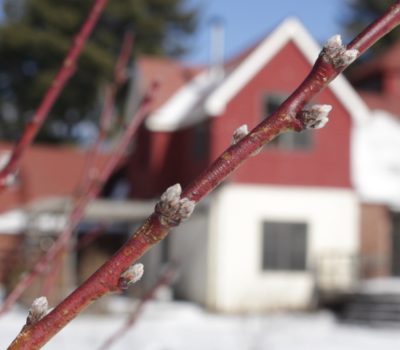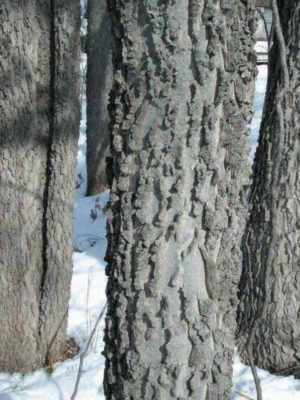This Bud’s for You
Swelling Buds
What an exciting time of year! After a spate of 50 plus degree temperatures, lawn grass — bare now although it could be buried a foot deep in snow by the time you read this — has turned a slightly more vibrant shade of green. Like a developing photographic film (remember film?), the balsam fir, arborvitae, and hemlock trees I’m looking at outside my window, have also greened up a bit more.
Going outside to peer more closely at trees and shrubs reveals the slightest swelling of their buds. Earlier in winter, no amount of warmth could have caused this. As a cold weather survival mechanism, hardy trees and shrubs are “smart” enough to know to stay dormant until warm weather signals that it’s safe for tender young sprouts and flowers to emerge.
These plants stay asleep until they’ve experienced a certain number of hours of cool temperatures, the amount varying with both the kind and variety of plant.
Once that cold “bank” has been filled, the plants merely respond to warming temperatures. Which, for many plants, is now.
Physiology aside, the buds provide an interesting winter diversion; look at their sizes, their shapes, their colors, and textures. (Admittedly, their interest would pale in the landscape exploding into flowers and leaves, when the buds anyway mostly disappear into flowers or leaves until later in summer when new ones re-form.)
More than just interest, buds are useful. Buds can be used to identify the kind of plant as well as whether flower buds are in the offing. Or perhaps that flower buds were in the offing but were damaged by winter cold.
Info from Buds
The first bit of information I glean from winter buds is plant identification. To begin, how are the buds arranged along the stem? Buds directly opposite each other, which is relatively rare for local trees, narrows the choice down to maple, ash, dogwood, and horse chestnut, or, as some people remember it, MAD Horse.

L to R: peach, pawpaw, fantail willow, viburnum, dogwood
Of course, once I identify a tree as, for example, a maple, I have to look for other details, such as the bark, to tell if it is a red, sugar, silver, or Norway maple.
(A few less common trees also have opposite leaves, including katsura and paulownia, both non-native, and viburnums, some of which are native. Most shrubs have opposite leaves.)
Buds that are not opposite each other along a stem might be alternating along the stem, they might be whorled, or they might be almost, but not quite opposite, presenting a much wider field of plants from which to choose.
Then it’s time for a closer look at the buds themselves. Some plants—viburnums, for example—have naked buds, enveloped only by the first pair of (small) leaves, rather than the scaly covering protecting the buds of most other plants. Buds of plants such as maples have buds enclosed in scales that overlap like roof shingles. Or two or three scales might enclose a bud without any overlap, as they do on tuliptree.
Mature plants have two kinds of buds. Those that are longer and thinner will expand into shoots. Flower buds are usually fatter and rounder. I note how dogwood flower buds stand proud of the stems like buttons atop stalks — very decorative if you take the time to have a look. I take a look at a peach branch with its compound bud: a single, slim stem bud in escort between two fat flower buds.

Peach buds
Apple and crabapple flower buds occur mostly at the ends of stubby stems, called spurs, that elongate only a half an inch or so yearly. Pawpaws fruit buds are fat and round with a brown, velour, covering.
Practicalities aside, buds can predict what kind of flower show or fruit crop to expect, barring interference from late frosts, insects, diseases, birds, or squirrels. If peach fruit buds just sit in place rather than fattening as winter draws to a close, I’ll know that the night back in January when temperatures plummeted to minus 18 degrees Fahrenheit did them in, or at least some of them.
More Winter Details
Back to winter plant identification and entertainment. Looking more carefully at these leafless plants promotes familiarity. Notice the intricacies of their various barks; shagboark hickory, sugar maple, persimmon, white birch, and, my favorite, hackberry,

Hackberry bark
are very characteristic. Note twigs’ color, presence of ridges or lenticels (corky pores), even their taste or aroma. The aromas of yellow birch (wintergreen aroma), sassafras, and black cherry (almond) practically shout out their identification.

